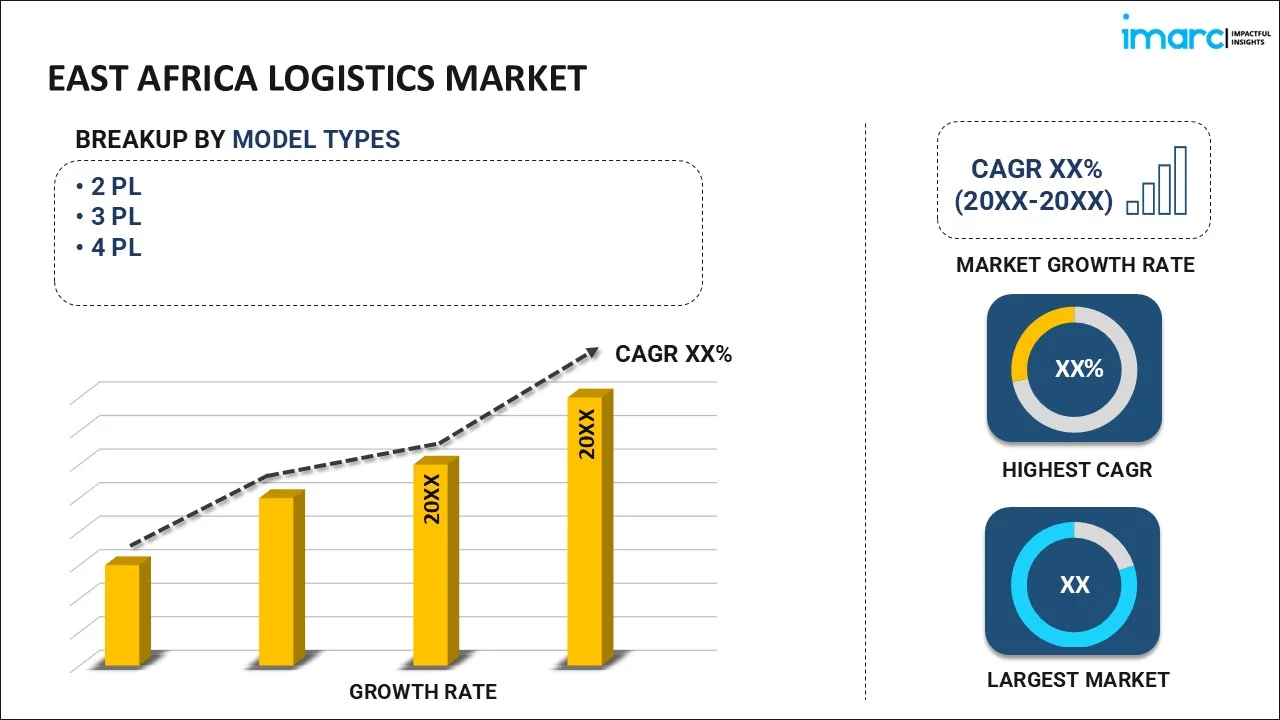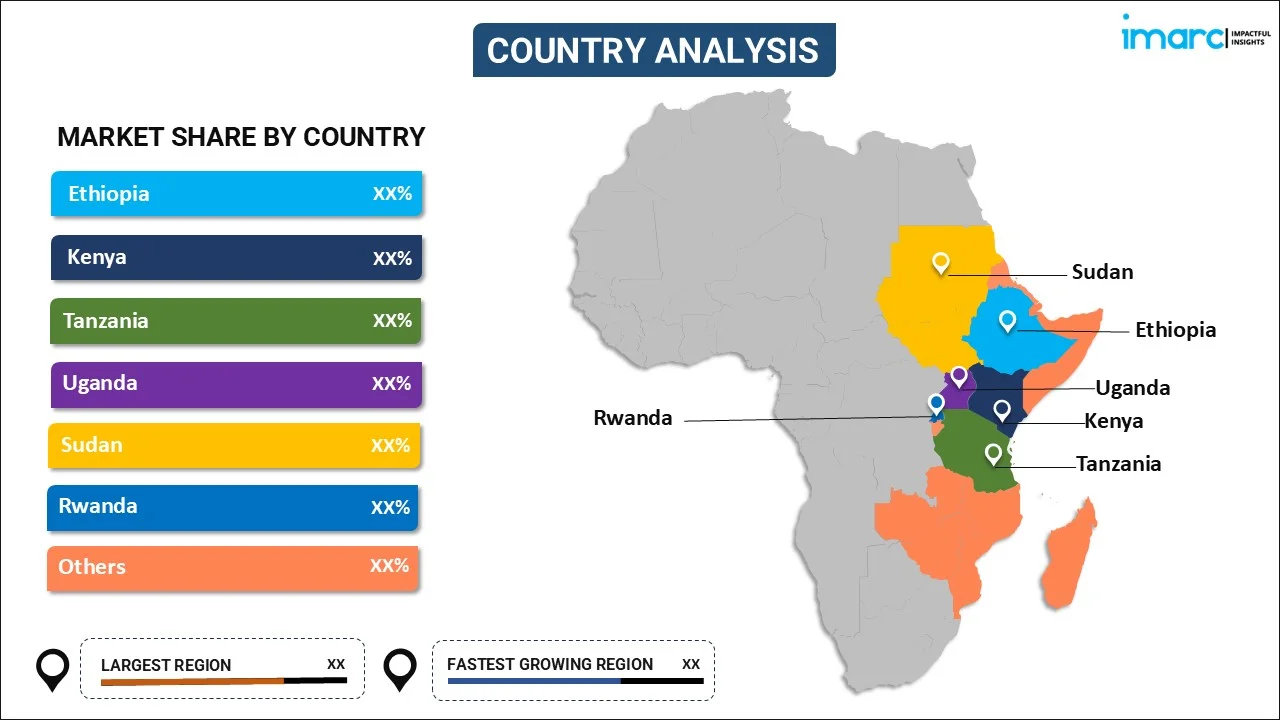
East Africa Logistics Market Report by Model Type (2 PL, 3 PL, 4 PL), Transportation Mode (Roadways, Seaways, Railways, Airways), End Use (Manufacturing, Consumer Goods, Retail, Food and Beverages, IT Hardware, Healthcare, Chemicals, Construction, Automotive, Telecom, Oil and Gas, and Others), and Country 2026-2034
Market Overview:
The East Africa logistics market size reached USD 25.1 Billion in 2025. Looking forward, IMARC Group expects the market to reach USD 37.8 Billion by 2034, exhibiting a growth rate (CAGR) of 4.67% during 2026-2034. The increasing infrastructure development programs, the significant expansion in the e-commerce and retail sector, and the implementation of various initiatives to enhance trade facilitation and reduce trade barriers, including streamlining customs procedures, represent some of the key factors driving the market.
|
Report Attribute
|
Key Statistics
|
|---|---|
|
Base Year
|
2025
|
|
Forecast Years
|
2026-2034
|
|
Historical Years
|
2020-2025
|
|
Market Size in 2025
|
USD 25.1 Billion |
|
Market Forecast in 2034
|
USD 37.8 Billion |
| Market Growth Rate 2026-2034 | 4.67% |
Access the full market insights report Request Sample
Logistics is a fundamental aspect of business operations that revolves around the effective management of the flow of goods and services from the point of origin to the point of consumption. It comprises several activities, all aimed at ensuring that products and services are delivered to customers efficiently and cost-effectively. They are essential in the supply chain, facilitating the movement and distribution of goods while optimizing processes to enhance business performance. It involves selecting the most appropriate modes of transportation, such as road, rail, air, or sea, to move goods from one location to another. They reduce costs and ensure timely delivery, which is essential in meeting customer expectations. Additionally, logistics professionals must consider route planning, fuel efficiency, and compliance with regulations to minimize environmental impact and maintain legal standards. Also, warehousing and inventory management are an integral component of logistics. They serve as storage hubs for goods, and their strategic placement can significantly reduce transportation costs and delivery times. Effective inventory management ensures that businesses have the right number of products in stock to meet customer demand without excess, which can tie up capital and increase carrying costs. Nowadays, logistics include order processing, packaging, and even reverse logistics, which deals with product returns and recycling to streamline processes, minimize costs, and maximize customer satisfaction.
East Africa Logistics Market Trends:
The market is primarily driven by investments in infrastructure development programs across the region. In addition, it facilitates the growth of the logistics sector in East Africa, allowing governments in the region to focus on improving transportation networks, including roads, railways, and ports, which is influencing the market growth. Also, the growing construction and modernization of transportation infrastructure are reducing transportation bottlenecks, lowering logistics costs, and improving the overall efficiency of supply chains, augmenting the market growth. Moreover, the significant expansion in the e-commerce and retail sector has had a profound impact on the logistics market, representing another major growth-inducing factor. Along with this, the rising online shopping and the establishment of modern retail chains are escalating the need for last-mile delivery and distribution services, resulting in the adoption of logistics companies, providing innovative solutions to meet the demands of e-commerce and retail customers, propelling market growth. Besides this, the implementation of various initiatives to enhance trade facilitation and reduce trade barriers, including streamlining customs procedures, implementing trade facilitation agreements, and promoting the use of technology in logistics and supply chain management, improved the overall business environment for logistics companies, which is accelerating the market growth. Apart from this, the implementation of various initiatives to enhance trade facilitation and reduce trade barriers, including streamlining customs procedures, implementing trade facilitation agreements, and promoting the use of technology in logistics and supply chain management to improve the overall business environment for logistics companies operating in the region are contributing to the market growth.
East Africa Logistics Market Segmentation:
IMARC Group provides an analysis of the key trends in each segment of the market, along with forecasts at the regional and country levels for 2026-2034. Our report has categorized the market based on model type, transportation mode, and end use.
Model Type Insights:

To get detailed segment analysis of this market Request Sample
- 2 PL
- 3 PL
- 4 PL
The report has provided a detailed breakup and analysis of the market based on the model type. This includes 2 PL, 3 PL, and 4 PL.
Transportation Mode Insights:
- Roadways
- Seaways
- Railways
- Airways
A detailed breakup and analysis of the market based on the transportation mode have also been provided in the report. This includes roadways, seaways, railways, and airways.
End Use Insights:
- Manufacturing
- Consumer Goods
- Retail
- Food and Beverages
- IT Hardware
- Healthcare
- Chemicals
- Construction
- Automotive
- Telecom
- Oil and Gas
- Others
The report has provided a detailed breakup and analysis of the market based on the end use. This includes manufacturing, consumer goods, retail, food and beverages, IT hardware, healthcare, chemicals, construction, automotive, telecom, oil and gas, and others.
Country Insights:

To get detailed regional analysis of this market Request Sample
- Ethiopia
- Kenya
- Tanzania
- Uganda
- Sudan
- Rwanda
- Others
The report has also provided a comprehensive analysis of all the major regional markets, which include Ethiopia, Kenya, Tanzania, Uganda, Sudan, Rwanda, and Others.
Competitive Landscape:
The market research report has also provided a comprehensive analysis of the competitive landscape in the market. Competitive analysis such as market structure, key player positioning, top winning strategies, competitive dashboard, and company evaluation quadrant has been covered in the report. Also, detailed profiles of all major companies have been provided.
East Africa Logistics Market Report Coverage:
| Report Features | Details |
|---|---|
| Base Year of the Analysis | 2025 |
| Historical Period | 2020-2025 |
| Forecast Period | 2026-2034 |
| Units | Billion USD |
| Scope of the Report | Exploration of Historical and Forecast Trends, Industry Catalysts and Challenges, Segment-Wise Historical and Predictive Market Assessment:
|
| Model Types Covered | 2 PL, 3 PL, 4 PL |
| Transportation Modes Covered | Roadways, Seaways, Railways, Airways |
| End Uses Covered | Manufacturing, Consumer Goods, Retail, Food and Beverages, IT Hardware, Healthcare, Chemicals, Construction, Automotive, Telecom, Oil and Gas, Others |
| Countries Covered | Ethiopia, Kenya, Tanzania, Uganda, Sudan, Rwanda, Others |
| Customization Scope | 10% Free Customization |
| Post-Sale Analyst Support | 10-12 Weeks |
| Delivery Format | PDF and Excel through Email (We can also provide the editable version of the report in PPT/Word format on special request) |
Key Questions Answered in This Report:
- How has the East Africa logistics market performed so far and how will it perform in the coming years?
- What has been the impact of COVID-19 on the East Africa logistics market?
- What is the breakup of the East Africa logistics market on the basis of model type?
- What is the breakup of the East Africa logistics market on the basis of transportation mode?
- What is the breakup of the East Africa logistics market on the basis of end use?
- What are the various stages in the value chain of the East Africa logistics market?
- What are the key driving factors and challenges in the East Africa logistics?
- What is the structure of the East Africa logistics market and who are the key players?
- What is the degree of competition in the East Africa logistics market?
Key Benefits for Stakeholders:
- IMARC’s industry report offers a comprehensive quantitative analysis of various market segments, historical and current market trends, market forecasts, and dynamics of the East Africa logistics market from 2020-2034.
- The research report provides the latest information on the market drivers, challenges, and opportunities in the East Africa logistics market.
- Porter's five forces analysis assist stakeholders in assessing the impact of new entrants, competitive rivalry, supplier power, buyer power, and the threat of substitution. It helps stakeholders to analyze the level of competition within the East Africa logistics industry and its attractiveness.
- Competitive landscape allows stakeholders to understand their competitive environment and provides an insight into the current positions of key players in the market.
Need more help?
- Speak to our experienced analysts for insights on the current market scenarios.
- Include additional segments and countries to customize the report as per your requirement.
- Gain an unparalleled competitive advantage in your domain by understanding how to utilize the report and positively impacting your operations and revenue.
- For further assistance, please connect with our analysts.
 Request Customization
Request Customization
 Speak to an Analyst
Speak to an Analyst
 Request Brochure
Request Brochure
 Inquire Before Buying
Inquire Before Buying




.webp)




.webp)












